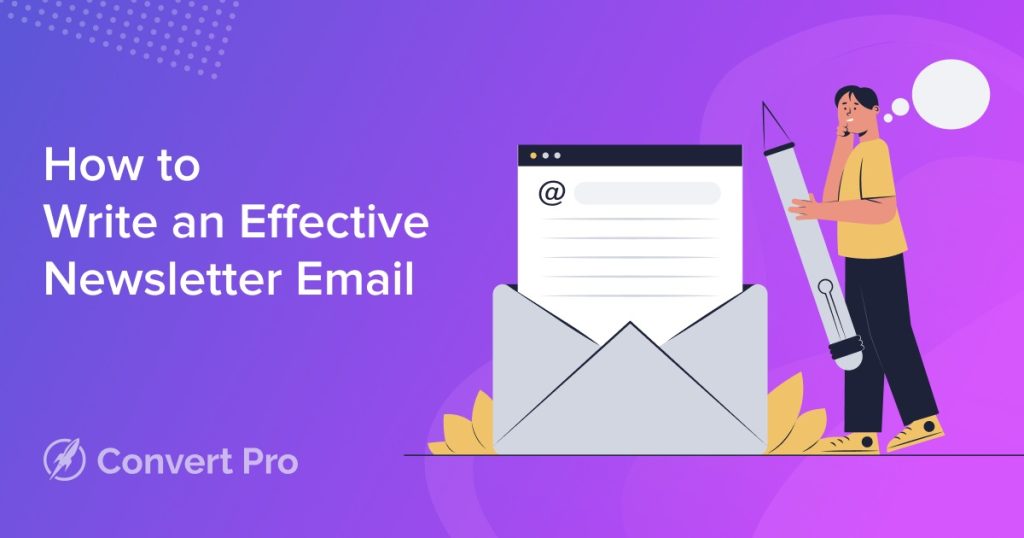Email marketing is not just about sending out promotional emails. It’s a channel for communicating and building relationships with customers.
At its core, creating newsletters is close to content marketing, which aims to give the reader helpful information. But signing up to receive emails shows the reader’s interest in your products or services, so it’s crucial to find a reasonable balance between advertising and benefit to the reader.
In this article, we will explain how to write an effective newsletter email and how to evaluate the effectiveness of email marketing.
5 key benefits of effective email newsletters for a business
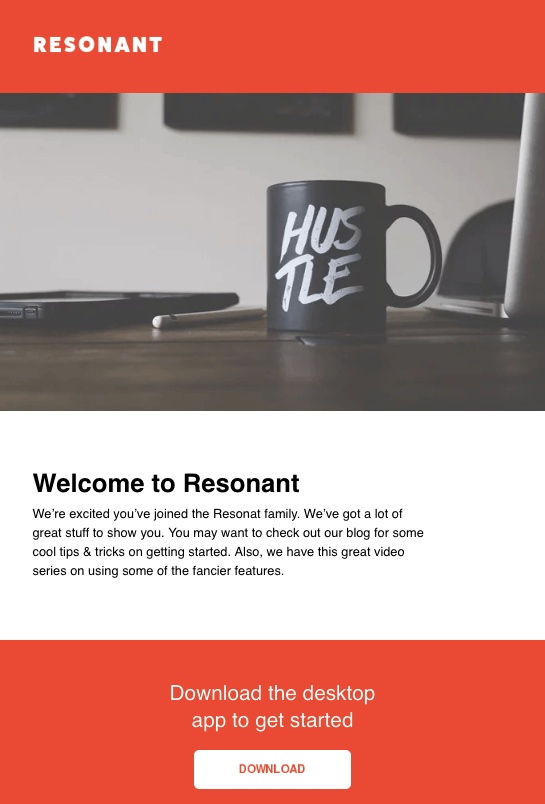
Creating a newsletter is helpful for many different types of businesses.
It can be used when selling everything from everyday goods all the way to expensive services. It will be especially effective if you know the needs of your target audience well and prepare exciting and relevant content for them.
5 key benefits of email newsletters include:
- Gathering target audience. With the help of an email newsletter, you can gather a base of potential customers interested in your products or services through a form on the site.
- Direct sales. People sign up for emails when they plan to buy a product or service but can’t do it now (have doubts about the choice, lack of money, or time). Email newsletters remove possible objections, answer the subscriber’s questions and can lead to a purchase.
- Reminders and repeat sales. You can set up a mailing to customers who have already purchased and lead them to new purchases. You can use newsletter emails to remind people to repurchase products (for example, lenses) or update their membership.
- Attention to customers. Emails can educate and entertain the subscriber. For example, congratulate them on their birthday or tell them about an improvement in a product they were interested in. This increases customer loyalty.
- Feedback. After the purchase, you can send the customer a questionnaire and get feedback on your work and products.
As you can see, an email newsletter can do a lot for businesses, including helping increase sales, build loyalty, and gather feedback.
How to create a newsletter email that people read
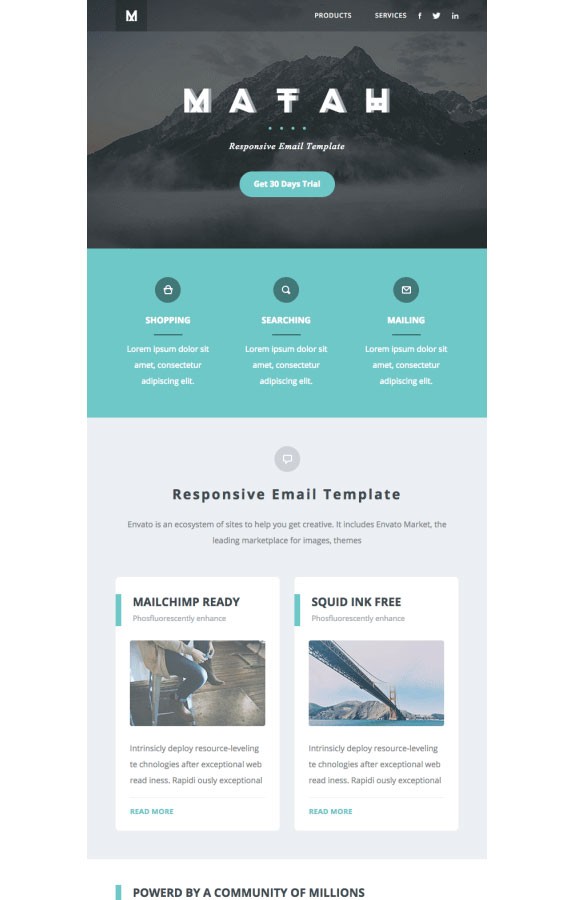
Creating a newsletter email that converts is not difficult if you know 9 simple rules.
Rule 1: Start with the overall concept
Any commercial text is part of a company’s marketing strategy. You need to understand what the company sells and who its target audience is to get the most out of it.
Knowing the audience enables you to use their language, speak to them on their level to make a connection and generally improve communication.
When you create a newsletter email, you should consider the audience. This is because the target audience’s characteristics are the basis of any promotion.
Rule 2: Craft a compelling subject line and preview text
The subject line and preview text should briefly reflect the content of the email and motivate the reader to open the message. A vague subject line doesn’t capture attention and the email is likely to go unopened.
our email is probably one of a dozen similar emails from competitors. To get an advantage, make your subject line and preview text as straightforward and motivating as possible since 82% of experts use subject lines with 60 characters or less.
Don’t cheat or make false promises in the subject line. This is a sure way to end up in spam or get blacklisted.
Rule 3: One goal, one letter
Before you start writing a newsletter email, decide what you want to do: sell a product, call a subscriber to an event or increase loyalty.
Each task will have its type of newsletter email. Promo emails suit best for sales, while content emails for increasing loyalty.
| Newsletter email purpose | Newsletter email type | Newsletter email requirements |
|---|---|---|
| Talk about the company, introduce the new product | Welcome email | Such an email should talk about the company’s features and the product, and what is exciting or valuable to the subscriber. |
| Sell a product | Promo email | Such an email should have a solid motivation to buy, quote, and handle objections to match the interests and pain points of the target audience. |
| Increase customer loyalty | Content email | Such email should have exciting or helpful information that will help solve customers’ problems, handle objections, and have emotional storytelling. It can be in the form of a digest, longreads, FAQs, or how-tos. |
| Remind about the abandoned cart, confirm the order | Transactional email | Such an email should have short text but include all the necessary information about the order (order number, cost, delivery time, and so on.) An offer or some critical advantages of the items in the abandoned cart. |
| Bring back subscribers or clients who haven’t opened your mailing list or bought your products for a long time | Reactivation email | The subject of this email should state its aim, and the text should briefly remind the reader about the practical benefit of the mailing or the product. |
Don’t try to put everything into one newsletter email. Use the one goal, one letter principle and try to keep things focused.
Rule 4: Keep important information to the beginning of the email
If you offer subscribers a discount, tell them about it at the beginning of the email. Better yet, put it on the banner and in the subject line. If you have something to offer the customer, don’t hesitate to say it loudly.
Rule 5: Keep the text simple
Complex, abstruse texts aren’t inclusive and can alienate parts of your audience. Write simply and clearly, so that even your grandmother understands.
A few rules to help with this:
- Avoid passive voice, clauses, and compound sentences
- Don’t use a lot of adverbs
- Keep things simple and personal: instead of “cleaning is done on Tuesdays and Thursdays by the company staff” write “we clean on Tuesdays and Thursdays”
- Don’t write phrases that have no value, like, “It’s been known for a long time that clients don’t like to listen to experts.” Known by whom? Proven by whom? Don’t be like that.
- Don`t use compound-complex sentences. For example: “We know you love to learn English so we propose you enroll at Udemy later this week because it has many exciting English courses.”
If you are not sure about your newsletter email text, you can turn to online proofreading services like Essay Writer.
Rule 6: Add a call to action
Your newsletter email aims to get the customer to do something you want. You need to push them: add calls to action buttons and make them visible.
The main rule is clarity. The user must understand what you want from him at once. In this case, one word wins over a sentence: less time spent reading – faster understanding.
Verbs work well in CTAs. A verb is an action. If it’s in the button, the subscriber will immediately understand the targeted action to take. Use a verb in your CTA: “buy”, “do”, “follow”. Examples are “Select shoes now!” and “Go to catalog!”
Using a verb in button text is a tip, not a rule. But you might as well limit yourself to a noun – “Catalog,” “Shoes,” “Details,” and so on. That will work, too.
Rule 7: Theme and preheader must attract attention.
Don’t be afraid to keep the text short and concise: ruthlessly remove everything that doesn’t affect the meaning or push the story forward. That can include superfluous pronouns, introductory words and unnecessary descriptions.
Compare what sounds better:
- “Only today we have a unique offer on all washing machines and microwaves”
- “Today a 20% discount on washing machines and microwaves”
The second one sounds better. If you have a short preheader, put an exclamation point, a question mark, or a period in the end, so the preheader doesn’t blend in with the main text.
Rule 8: Make a brief footer
For most email marketers, the perfect footer is a single “unsubscribe” phrase.
If you want a full-fledged unsubscribe phrase, write simply, “If you don’t want to receive our emails, click unsubscribe.” Keep it short and to the point so you don’t take up too much room.
Rule 9: Make it 90% educational and 10% promotional
A rule of thumb for newsletter content selection is to combine 90% educational and 10% promotional content in the newsletter emails. This is referred to as the 90/10 rule.
Subscribers are tired of receiving promotional emails with urgent calls to action “buy now”. So it’s worth moderating the self-promotion and over-intrusiveness.
Focus on educational, relevant, and timely information that could be genuinely useful to your subscribers.
Examples of top-performing email newsletters
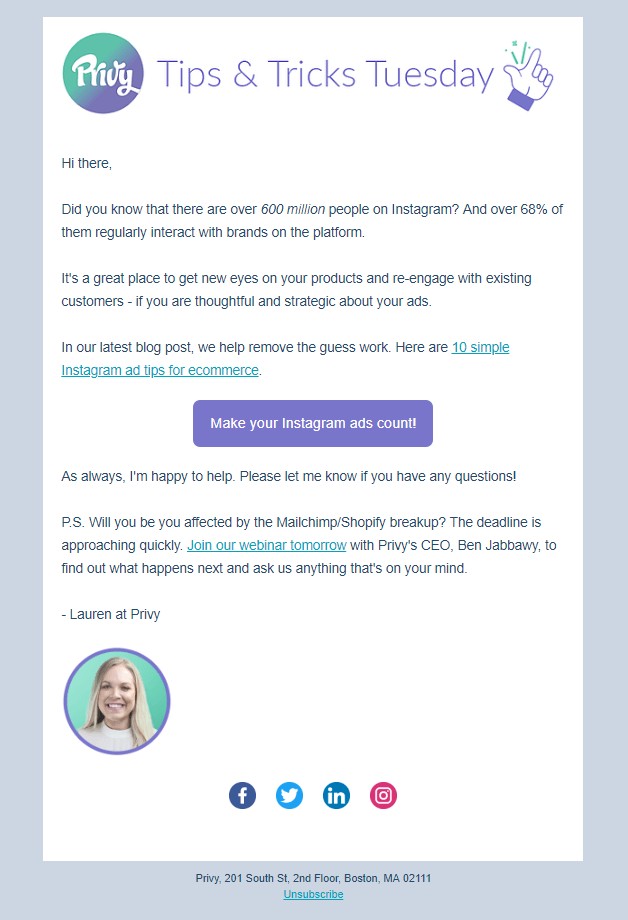
Privy is a service for creating subscription forms and A/B testing. The newsletter sends links to valuable articles from the blog. The newsletter email has a minimalistic design, and each email is devoted to one problem, so the selected topic gets more coverage.
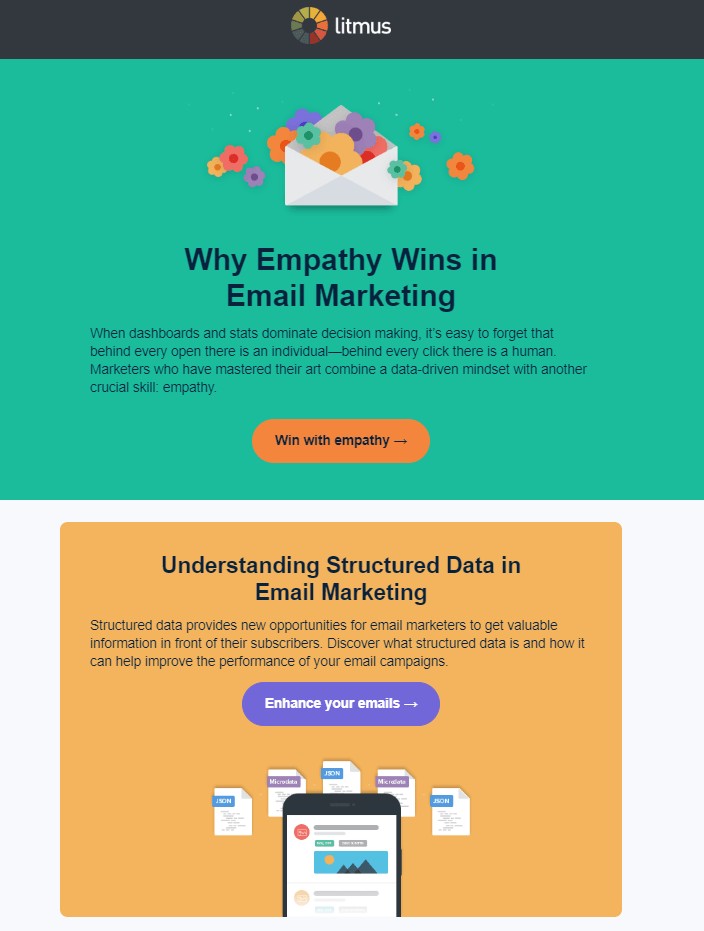
Litmus helps test how emails display on the web, mobile, and desktop platforms. Litmus newsletters talk about email marketing, tell you what’s new on the blog, and send you the results of their research.
They create useful newsletter emails for marketers and often experiment with design and try out new tricks in their emails. And, of course, the content: Litmus helps email marketers worldwide stay up to date.
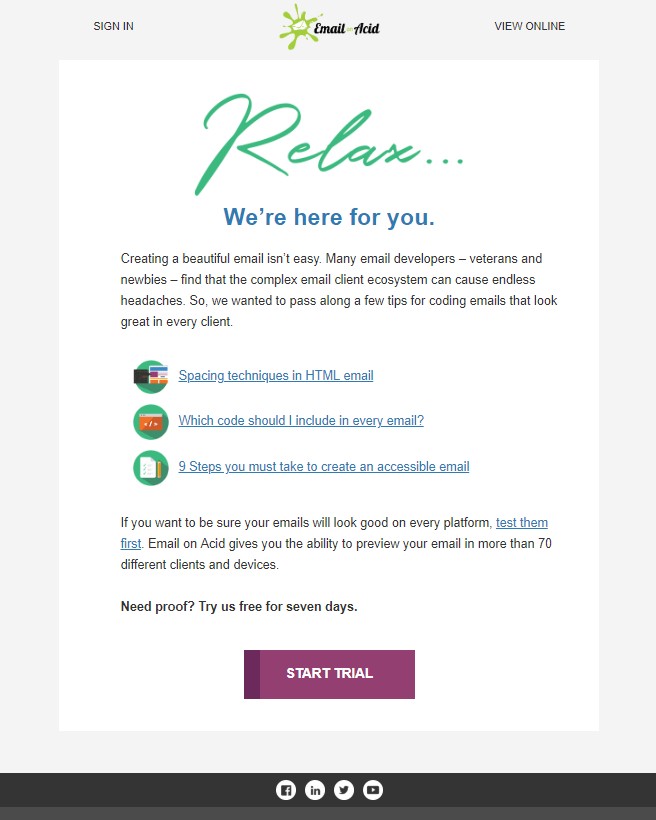
Email On Acid is another service for checking emails on different platforms. They send links to important articles from the blog, tell you about new features in the service, and invite you to its webinars.
Email On Acid has short, minimalist emails and the content encourages the reader to try the service. Their welcome email chain is excellent.
First, they greet us and introduce us to the service, then give us 600 templates, and in the following email, lead us by hand through important articles from the blog — all to make it easier for a person to get started with Email On Acid.
We started a mailing list. What’s next?
Creating a newsletter email is only half the battle. You still need to solve any problems that may arise, improve email content and analyze its effectiveness.
Let’s discuss these further.
If emails end up in spam

Before starting a newsletter campaign, send it to several of your addresses in different email account services. Go to your email account and check if the email is in your spam folder.
Gmail will send an email to the spam folder if a subscriber has already marked your email as spam. Mailchimp will block your account if your spam email exceeds the critical 0.5%.
The most common reasons why emails end up in spam include:
- SPF (Sender Policy Framework) not configured
- DKIM (Domain Keys Identified Mail) not configured
- DMARC (Domain-based Message Authentication Reporting and Conformance) not configured
- No Double Opt-in
- Purchased databases of emails
If everything is okay with above things, adhere to next rules:
- Each email should have a subject line. It should briefly reflect the essence of the email. Do not make it too long to take up the whole line. Also, do not write all the words in capital letters in the subject line.
- Send newsletters from a corporate address. Otherwise, many email providers can recognize your emails as spam.
- Always be sure to write a text message in your newsletter emails. If you send only a picture to your subscribers, it might be considered spam.
- Don’t change the sender’s name unnecessarily. If the email comes from an unknown sender, the user might not recognize your company. He won’t look into the details and click the “Spam” button.
- Don’t collect emails from open sources, and don’t buy the email address database. You need to be sure of the legitimacy of the database to do the newsletter. If you are just starting an email campaign, send emails to a small sample of addresses first and watch the recipients’ reactions.
If more than 1% of your emails end up in spam, this is an alarm bell. Therefore it is necessary to promptly find out the reason for getting into spam and eliminate it.
Personalization: working with your subscriber base
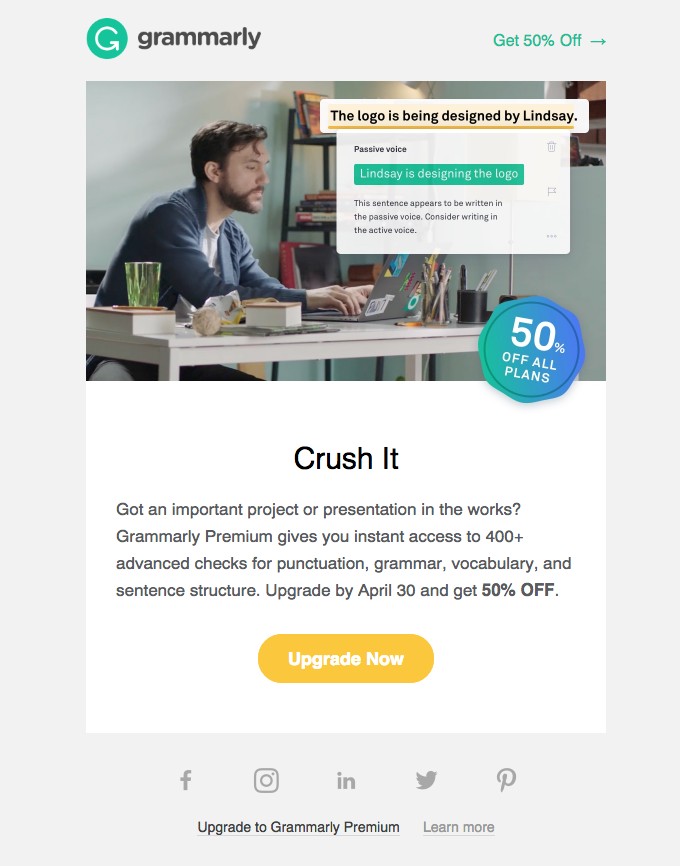
Divide subscribers into segments based on activity, location, last purchase date, clicks on certain links, birthday and other metrics.
Like all online advertising, newsletters are more effective if they are personalized – that is, they take into account subscriber data (name, date of birth, purchase history, and so on).
It’s easiest to include the subscriber’s name, but it’s not the most effective way to personalize.
The following data helps personalize the email:
- Specific personal data (birthday, children or pets, the person’s activities). Ask subscribers to fill out a particular form for a bonus or promo code to get this data.
- The place where the subscriber is and everything related to it (season of the year, weather, city, or district).
- Data from the database. Use an individual promo code, order payment information, last purchase or something else.
- Actions on the website. A reminder of an abandoned cart is the most common type of personalized email.
Using personalization, change not only the content but also the subject line of the email. This will increase the appeal of the newsletter in the eyes of the audience.
Evaluating the effectiveness of email marketing
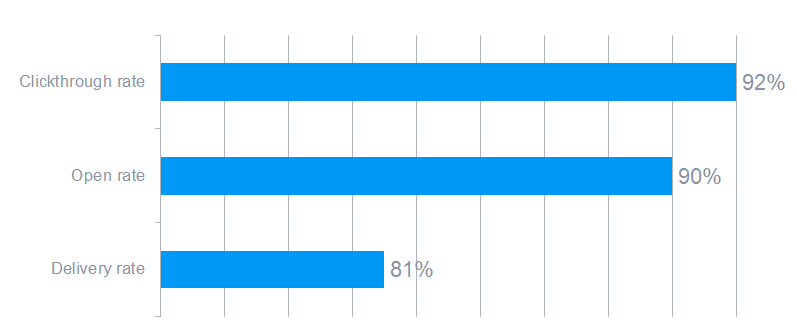
The metrics of email newsletter efficiency are usually divided into internal (percentage of opens, number of clicks on the site) and external (purchases from the email).
The internal metrics of an email newsletter reflect:
- Involvement of subscribers (open rate and clickability indicators). The higher the email open rate, the more loyal your readers are. The higher the clickability, the better you can engage the email.
- Subscriber retention (bounce rate, frequency of interactions). An increase or a high unsubscribing rate indicates that people do not like something in your emails. The frequency of the recipient’s interactions with the email allows you to understand how exciting and valuable your mailing is to the subscriber.
- The quality of your emailing (the percentage of delivery mistakes, spam complaints). Delivery mistakes happen if there are some problems. For example, the address does not exist anymore (if you have been gathering the email database for a long time). The recipients who didn’t receive the emails because of address errors are better deleted from the mailing list to get objective statistics of the emails.
External metrics show:
- Attracting subscribers (estimate the value of the subscriber, base growth). It is helpful to count the value of the subscriber from different advertising channels to identify the most and least effective.
- Monetization (evaluates conversions, total revenue per email, ROI). The easiest way to determine mailing effectiveness is to count the total revenue per email (RPE) from CRM applications or Google Analytics ecommerce reports.
These are 5 primary metrics for evaluating email marketing success.
Conclusion
An email newsletter allows you to effectively communicate with your subscribers and promote your products and services. But the result does not come right away.
So, let’s repeat:
- Before creating the email, research the client, their product, their target audience, and their communication styles.
- One email newsletter should be created for one goal.
- Newsletter email should start with the most important information.
- Text should be simple and clear.
- Newsletter email should contain CTA.
- Theme and the preheader must attract attention.
- Footer text should be brief.
- Personalization is a great technique for increasing the effectiveness of email.
Increased conversions are guaranteed if you learn how to create effective newsletter emails.
This is a guest article contributed by Vanessa Friedman.
Vanessa Friedman is a content marketing professional that helps companies attract visitors, convert leads and close customers. Previously, Vanessa worked as a marketing manager for a tech software startup. She graduated with honors from Columbia University with a dual degree in Business Administration and Creative Writing.
